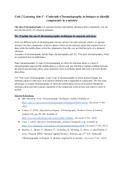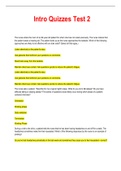Summary Lecture Slides
Topic 3 Disorders of Sensation and Perception
Scotoma: cortical blindness for a smaller region of the visual field opposite the
damaged hemisphere.
- Cause: partial damage to primary visual cortex (also V1 or striate cortex).
- Objects that are presented in the scotoma cannot be consciously perceived,
but some people are still able to make simple discriminations between stimuli
(e.g. form, colour).
Hemianophia: cortical blindness for the side of the visual field opposite the damaged
hemisphere.
- Cause: complete damage to one side of the primary visual cortex.
Blindsight: no conscious awareness of perceiving visual stimuli, but patients show
evidence that the stimuli are being perceived.
o Affective blindsight: patients with blindsight can sometimes
discriminate the emotion of stimuli they cannot consciously perceive.
o ‘Deaf hearing’: blindsight but then in the auditory system.
o ‘Blind touch’: blindsight but then in the somatosensory system.
- Rehabilitation: training can help.
Anton-babinski syndrome: opposite of blindsight. Patients are cortically blind but affirm that they are
capable of seeing. Failure to see is dismissed by the sufferer through confabulation.
Agnosia: deficit in object recognition that cannot be attributed to elementary sensory defects, mental
deterioration, attentional disturbances, aphasic misnaming, or unfamiliarity with presented stimuli.
- Visual agnosia:
1) Apperceptive agnosia: failure to understand the meaning of objects due to problems in early
stage perceptual processing: problem grouping visual sensations into a unified percept.
a. Common cause: carbon monoxide poisoning damage to posterior temporal and
occipital cortices (usually bilaterally).
b. Assessment: examples:
i. Presentations of objects in unusual views such as upside down.
ii. Copying simple line drawings.
iii. Matching similar objects.
2) Associative agnosia: poor object recognition. Doesn’t involve faulty perception. The patient has
problems making meaningful associations to the presented stimuli.
a. Damage: left hemisphere posterior lesions.
b. Assessment: examples:
i. ‘Real or not’ test: pictures of objects/animals are presented patient is asked to
judge whether the picture represents a ‘real’ (plausible) object or not.
ii. Matching-by-function test: pictures of objects which ones have the same
function?
iii. Pyramid and palm tree test: pyramid, palm tree and normal tree are shown
which tree fits the pyramid?
- Auditory agnosia & tactile agnosia
Rehabilitation: no cure known. Patients may benefit from cues presented in other modalities than the
damaged one. Occupational and speech therapy may be helpful depending on the underlying pathology.
Prosopagnosia: inability to recognize faces. Cannot be attributed to sensory problems (blindness) or more
general intellectual deficits. Patients are often able to identify individuals by other cues (voice, hair, clothes).
, - Damage: right hemisphere lesions.
- Assessment: administering facial recognition tests.
o Famous faces test
o Present three times the same face next to each other present three different faces which
one is the same as the first three? Patients have trouble picking out the same face as it is lit
differently in the second picture.
o Using chimeras: i.e. pictures of animals acting like humans and/or wearing clothes.
Subtypes:
1) Apperceptive prosopagnosia: the face cannot be properly perceived: features cannot be grouped
into a unified percept. Faces look distorted.
2) Associative prosopagnosia: disconnection between the patient’s perception of the face and the
semantic information about the person. Typically such people do not report that ‘faces make no
sense’, but simply that they do not look distinctive in any way.
Rehabilitation: few effective therapies available. Patients learn to use recognition strategies (using clues
such as clothes, hair, body shape and voice).










